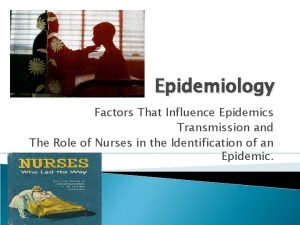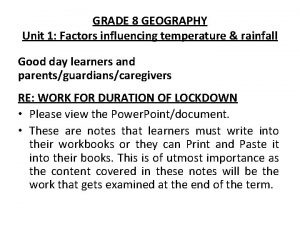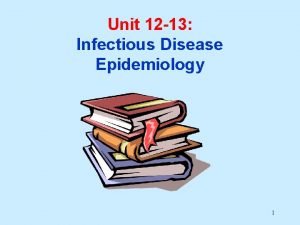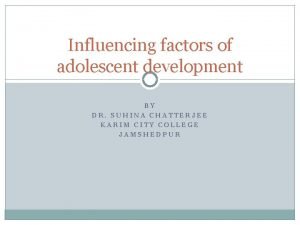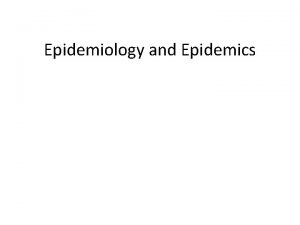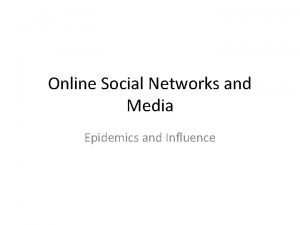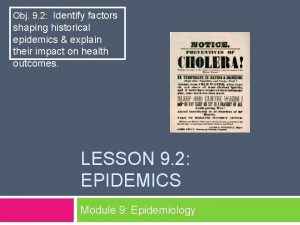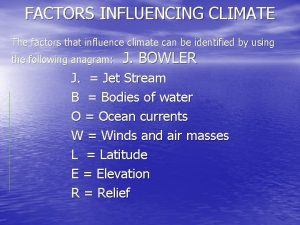Epidemiology Factors That Influence Epidemics Transmission and The



























- Slides: 27

Epidemiology Factors That Influence Epidemics Transmission and The Role of Nurses in the Identification of an Epidemic.

Factors That May Influence Epidemics Host susceptibility – How susceptible is individual to coming down with infectious disease? 1. Immunization Genetic background Health of individual ◦ Young and old are especially susceptible. Culture ◦ Hispanics might be more affected by flu because they are big huggers. Religion ◦ What you believe can help/hinder your chances of surviving an infectious disease. Some religions do not permit invasive procedures (vaccinations included), seeking medical attention etc. . .

Factors That May Influence Epidemics 2. Time of year summer is usually the worst time because people are out socializing a lot.

Factors That May Influence Epidemics Parasite/infectious entity and its pathogenicity 3. Its ability to adhere to host (attach and stay with) Its invasiveness (how easily does it get into the body)

Factors That May Influence Epidemics Parasite/infectious entity and its pathogenicity Its antigenic variation (mutation) 3. ◦ Plagues mutate really quickly. You might treat it one way and then it mutates and you have to figure out how to treat the new mutation. Ability of the pathogen to exist as an intracellular pathogen ◦ Can it get inside the cell and propagate HIV, AIDS, Malaria, Chlamydia

Factors That May Influence Epidemics Parasite/infectious entity and its pathogenicity 3. Ability of the pathogen to produce toxins ◦ Botulism Dose of an agent – how much of organism has to enter the body or come in contact with it. ◦ Salmonella – need 100, 000 cells ◦ Shigella – need only 10 cells (more virulent than salmonella)

Factors That May Influence Epidemics Parasite/infectious entity and its pathogenicity 3. Incubation period – you can communicate a disease before you even know you have it. ◦ HIV, Chlamydia


Strategies of Pathogens to Exist/Survive Formation of cyst – dormant (protozoan) Endospores Mutation (antigenic variation) Intracellular pathogen Development of a complex life cycle Capsules (bacteria/yeast)

Control of Epidemics Reduction of source of infection Quarantine Destroy infected host

Control of Epidemics Disruption of chain of Transmission Destroy vectors Pasteurization – 60°C for 30 minutes Flash pasteurization – 72°C for 15 seconds Water treatment

Control of Epidemics Immunization Best way to protect the entire population is to have as many citizens immunized.

Control of Epidemics Control of hospital acquired and community acquired infection Nosocomial – an infection acquired in a health related facility.

Control of Epidemics Surveillance The job of CDC and state health departments. There is a certain set of infectious diseases that doctors/schools/hospitals must report immediately. ◦ ◦ ◦ Salmonella Rabies Botulism Shigella Anthrax

Who is the primary defense against epidemics? NURSES!! (Healthcare Workers) They see things before anyone else. People who are really sick are going to the ER not to their family doctor.

Manifestations of Disease: Symptoms, Signs, and Syndromes ◦ Symptoms – subjective characteristics of disease felt only by the patient ◦ Signs – objective manifestations of disease that can be observed or measured by others ◦ Syndrome – group of symptoms and signs that characterize a disease or abnormal condition ◦ Asymptomatic, or subclinical, infections lack symptoms but may still have signs of infection

Signs and Symptoms: Warning Signals of Disease Sign: any objective evidence of disease as noted by an observer Symptom: the subjective evidence of disease as sensed by the patient Syndrome: when a disease can be identified or defined by a certain complex of signs and symptoms

Signs and Symptoms of Inflammation Fever, pain, soreness, swelling Edema Granulomas and abscesses Lymphadenitis Lesion: the site of infection or disease

Signs of Infection in the Blood • • • Changes in the number of circulating white blood cells Leukocytosis Leukopenia Septicemia: general state in which microorganisms are multiplying in the blood and are present in large numbers Bacteremia or viremia: microbes are present in the blood but are not necessarily multiplying

Infections that Go Unnoticed Asymptomatic, subclinical, or inapparent infections Most infections do have some sort of sign

Nosocomial Infections: The Hospital as a Source of Disease Nosocomial infections: infectious diseases that are acquired or develop during a hospital stay 2 -4 million cases a year The importance of medical asepsis

Hospital Epidemiology: Nosocomial Infections ◦ Types of nosocomial infections Exogenous – pathogen acquired from the health care environment Endogenous – pathogen arises from normal microbiota due to factors within the health care setting Iatrogenic – results from modern medical procedures

Hospital Epidemiology: Nosocomial Infections ◦ Control of nosocomial infections Involves precautions designed to reduce the factors that result in disease Hand washing is the most effective way to reduce nosocomial infections

Universal Blood and Body Fluid Precautions Universal precautions (UPs): guidelines from the Centers for Disease Control and Prevention ◦ Assume that all patient specimens could harbor infectious agents ◦ Include body substance isolation (BSI)techniques to be used in known cases of infection

Epidemiology of Public Health ◦ Agencies at the local, state, national, and global level share information concerning disease The United States Public Health Service is the national public health agency World Health Organization (WHO) coordinates public health services internationally ◦ Public health agencies work to limit disease transmission Monitor water and food safety ◦ Public health agencies campaign to educate the public on healthful choices to limit disease

Nationally Notifiable Infectious Disease

Peppe Thanks You for Keeping us Safe
 Factors that influence disease transmission
Factors that influence disease transmission Marcia
Marcia Phân độ lown ngoại tâm thu
Phân độ lown ngoại tâm thu Block xoang nhĩ là gì
Block xoang nhĩ là gì Thơ thất ngôn tứ tuyệt đường luật
Thơ thất ngôn tứ tuyệt đường luật Thơ thất ngôn tứ tuyệt đường luật
Thơ thất ngôn tứ tuyệt đường luật Walmart thất bại ở nhật
Walmart thất bại ở nhật Tìm vết của mặt phẳng
Tìm vết của mặt phẳng Hãy nói thật ít để làm được nhiều
Hãy nói thật ít để làm được nhiều Tôn thất thuyết là ai
Tôn thất thuyết là ai Gây tê cơ vuông thắt lưng
Gây tê cơ vuông thắt lưng Sau thất bại ở hồ điển triệt
Sau thất bại ở hồ điển triệt 5 factors that influence temperature and rainfall grade 8
5 factors that influence temperature and rainfall grade 8 What physiological factors produce hunger?
What physiological factors produce hunger? What three factors influence communication choices
What three factors influence communication choices Cultural and situational factors that influence hunger
Cultural and situational factors that influence hunger Factors that affect disease transmission
Factors that affect disease transmission Difference between descriptive and analytical epidemiology
Difference between descriptive and analytical epidemiology Define nutritional epidemiology
Define nutritional epidemiology Descriptive vs analytical epidemiology
Descriptive vs analytical epidemiology Difference between descriptive and analytical epidemiology
Difference between descriptive and analytical epidemiology Cbic recertification
Cbic recertification Epidemiology person place time
Epidemiology person place time Limiting factor examples
Limiting factor examples Management control systems 12th edition
Management control systems 12th edition What factors influence adolescent development
What factors influence adolescent development Local factors of wound healing
Local factors of wound healing Factors affecting rate of chemical reaction
Factors affecting rate of chemical reaction
